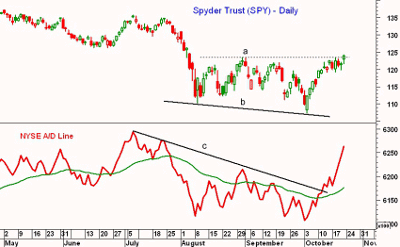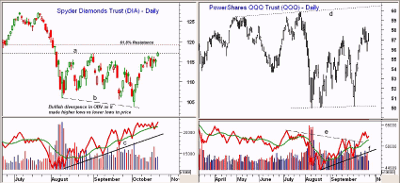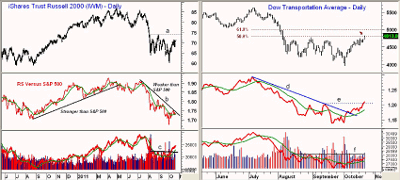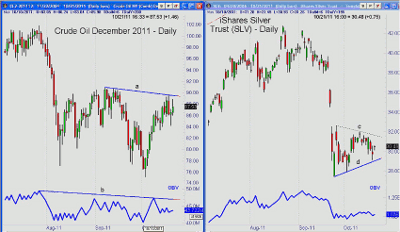Friday’s big bounce shouldn’t have been that surprising based on the charts, which tell us that the overall rally could run through year-end, especially in these favored sectors, writes MoneyShow.com senior editor Tom Aspray.
Wall Street professionals and the media are fixated on two things this week: the trading range in the stock-market averages, like the S&P 500, and the European summit over the weekend.
Very few are talking about the very bullish action of the market internals, which are painting a much more attractive picture.
Many investors were scared out of the market in August, which was not surprising. Professionals generally look at the fundamentals, and while there has been some improvement over the doom and gloom that prevailed last month, their outlook is cautious, if not bearish.
This chart of the Spyder Trust (SPY) and the NYSE Advance/Decline line is very revealing, at it shows a whole different story. The NYSE A/D is a cumulative total of advancing minus declining issues on the NYSE Exchange. Simply put, it gives an internal picture of the market’s health.
The NYSE A/D line has been declining since the July highs, but on October 11, it moved through its downtrend (line c). After a minor pullback last Monday, the A/D line has accelerated to the upside.
The SPY, on the other hand, is just trying to convincingly move above the upper boundaries of its recent trading range (line a).
The A/D line is clearly much stronger than prices. Historically, this means that prices will eventually catch up.
The A/D line is already very close to the July highs when the SPY was trading near $134. That is about 8% higher than the SPY is currently. As I noted last Wednesday, this action is similar to what occurred in the fall of 2010.
Over the years, there have been many other examples of this behavior, and though this doesn’t mean that we won’t still see sharp one- or two-day drops, it does indicate any declines will be well supported, with overall action bullish.
In looking at some of the sectors, I am also seeing some encouraging action—even in the beaten down financial. For example, Goldman Sachs (GS) reported a quarterly loss on Tuesday, leading to The Wall Street Journal’s headline “Pain Spreads to Biggest Banks.”
Later in the week, some of their editors were “flabbergasted” by the stock’s action, as GS held above Monday’s low at $94.65 and closed the week above $102.
Of course, many are waiting to see what type of rescue package comes out of the weekend meeting in Europe. If it is $1.3 trillion or more, stocks should surge Monday, as many are waiting for this news before they buy.
A lower number is likely to cause a sharp sell-off, which I think will be well supported. If it is supported, and stocks actually turn higher, the bulls could start to charge.
The economic news was generally better than expected, with the biggest surprise being some slightly encouraging data on the housing market. Technically, the homebuilders have completed short-term bottom formations, as volume suggests these stocks are being accumulated. (For specifics, see “Big Volume Is Bullish for Homebuilders.”)
We will get more information on housing this week, with the S&P Case-Shiller Housing Price Index on Tuesday and the new-home sales figures on Wednesday. Also out Tuesday are consumer confidence numbers.
On Wednesday, the market will also likely be watching the durable-goods report, which will be followed Thursday by the final readings on second-quarter GDP. Pending home sales and jobless claims are also scheduled for Thursday, with the personal income data finishing the week on Friday.
NEXT: What to Watch
|pagebreak|WHAT TO WATCH
Of course, there was plenty of movement in many of the other markets. Yields are well above the month’s lows, with the ten-Year Treasury yielding near 2.2%—well above the 1.72% level seen at the start of the month.
Gold was lower last week, and the Yen accelerated to the upside last Friday…so much for the carry trade.
S&P 500
The Spyder Trust (SPY) has held above support at $119 for the past eight days. Friday’s daily close above the August 31 high of $123.51 should signal upward acceleration.
The next key target is the 61.8% Fibonacci retracement resistance level at $125.82. There is further resistance standing in the $128 area and then at $130.
There is minor support at $121.50. If the SPY closed below $119, it would imply a drop to the $116 to $117 area.
Dow Industrials
The Spyder Diamonds Trust (DIA) closed well above the early-September high of $117.04 (line a) on Friday. The 61.8% retracement resistance level at $119.16. A close above it should signal a move to the $122 area.
The Dow Industrials A/D is acting stronger than prices, as is the on-balance volume (OBV). The OBV is well above the September highs, and shows a bullish divergence (line b) going back to the August lows.
DIA has first support now at $115, with more important levels around $112.83, which was last Tuesday’s low.
Nasdaq-100
The PowerShares QQQ Trust (QQQ), which has been the strongest sector, corrected the most last week as it tested the support in the $55.80 to $56 area. This was above the 38.2% retracement support at $55.16.
The 50% support for QQQ is at $54.50, with chart support between $54 and $53.50. On early October 4, it held above the prior lows of $49.99 and $49.93 (line e).
The next resistance for QQQ stands at $59 to $59.90, with trend line resistance (line d) in the $60.50 to $61 area.
The Nasdaq-100 A/D broke out of its trading range more than two weeks ago, and continues to show positive signs. The OBV moved through its downtrend (line f), and is acting stronger than prices, as indicated by line g.
NEXT: Small Caps, Sector Focus, and Tom’s Outlook
|pagebreak|Russell 2000
The iShares Russell 2000 Index Fund (IWM) is stalled below resistance in the $71.30 area. More important resistance waits at $73.75 (line a). IWM needs a close above this level to complete the bottom formation.
The 50% resistance level is at $73.45, while the 61.8% resistance is significantly higher at $76.60.
The RS analysis indicates that small caps, as represented by the Russell 2000, have been underperforming the S&P since April. The RS is in a steep downtrend (line b), but before the end of the year this is likely to change as the January effect kicks in.
As shown on the chart, the RS analysis was much stronger last year. The daily OBV has completed a bottom formation by moving above resistance (line c). The weekly (not shown) is still negative.
There is first good support for IWM at $68 to $68.50, with stronger levels in the $65 to $65.50 area.
Sector Focus
The Dow Jones Transportation Index peaked in May, when the weekly OBV formed a negative divergence.
The Transports closed last Friday above the resistance at 4,780, which was the 50% retracement level. The next target is the 61.8% resistance, standing at 5,000.
The RS analysis has improved, as it has broken its downtrend (line d) and moved above its WMA. It is now testing the August-September highs (line e), and a convincing move above this level will indicate that the Transports have started to outperform the S&P 500.
The OBV is lagging, and needs to move above the resistance (line f).
I continue to like the retail stocks as well as technology, as they have the best relative performance as well as a positive seasonal bias.
All of the sectors that I liked earlier in the month have moved higher, but the Select Sector SPDR Health Care (XLV) is lagging. The Select Sector SPDR Consumer Staples (XLP), Select Sector SPDR Technology (XLK), Select Sector SPDR Utilities (XLU), and Select Sector SPDR Consumer Discretionary (XLY) have broken out to the upside.
Two key sectors that topped in May, the Select Sector SPDR Energy (XLE) and the Select Sector SPDR Industrials (XLI) are starting to act much stronger, which is a positive sign.
NEXT: Oil, Metals, and Tom’s Outlook
|pagebreak|Oil
Crude oil is still locked in a trading range, as the December contract closed near its highs at $89.80. A strong close above the September high of $90.96 would clearly break the downtrend, and suggest a move to the $94 to $96 area.
The daily OBV is also still below resistance (line b), so volume on the rally will be important to watch.
Precious Metals
The SPDR Gold Trust (GLD) was able to rebound on Friday, so it’s possible that we will see one more push to the upside before the corrective pattern is complete. There is still strong resistance at $165, with the 50% Fibonacci retracement level standing at $170.
I still expect a drop to the $1500 level in the December Comex gold futures before the correction from the summer’s highs is over.
The daily chart of the iShares Silver Trust (SLV) shows a bearish short-term flag formation with the upper boundaries in the $31.50 area. Even a move above this level would not turn the outlook positive.
The gap in the $32.61 to $34.51 area could be filled before the decline resumes. However, I am still looking for an eventual drop to the $25 to $26 area.
The Week Ahead
The correction I was looking for last week ended up being quite brief in the overall market, even though the technology sector did correct more on the back of weak earnings of Apple (AAPL).
I hope you used any weakness to buy as I recommended on October 13’s article, “Buy the Dip." Though the widely watched ETFs had a very shallow setback, many of the individual stocks pulled back to good retracement support, which provided a good risk-reward entry point.
If my analysis is correct, we should see a rally that could last until the end of the year. If this is the case, I will look for signs that it is time to get into either mid- or small-cap stocks, but it is too early to tell now.
Be sure to use stops, and don’t chase the market…there will always be another opportunity.
- Don’t miss Tom’s latest Trading Lesson: Demystifying the MACD






















